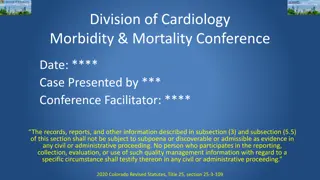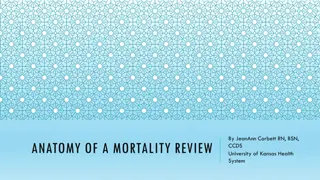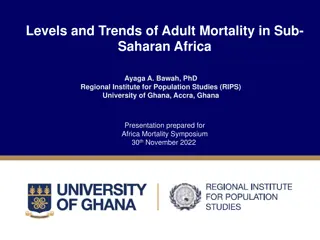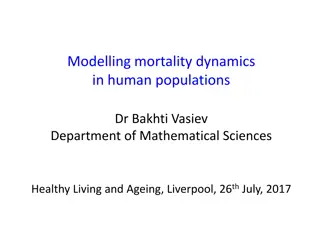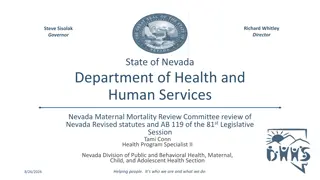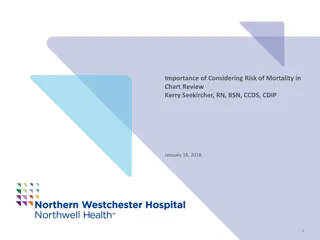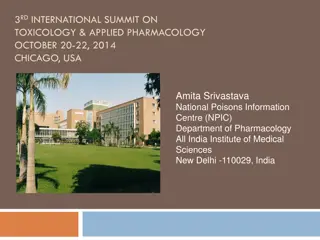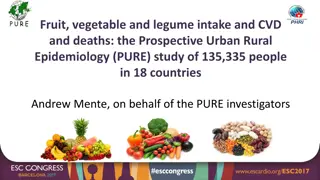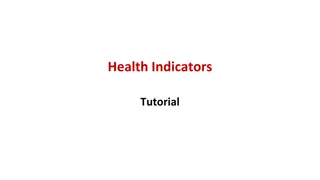Understanding Trends in Mortality and Morbidity in India
The paper discusses the perplexing rise in morbidity alongside improvements in various health and socioeconomic indicators in India. It explores the complex relationship between mortality and morbidity and the need for a combined macro and micro research approach to gain fresh insights into the issue. Additionally, it highlights contrasting experiences between the developed and developing world in terms of public health progress.
Download Presentation

Please find below an Image/Link to download the presentation.
The content on the website is provided AS IS for your information and personal use only. It may not be sold, licensed, or shared on other websites without obtaining consent from the author. Download presentation by click this link. If you encounter any issues during the download, it is possible that the publisher has removed the file from their server.
E N D
Presentation Transcript
Declining Mortality and Rising Morbidity in India: A Micro Perspective from Two Communities on Delhi s Periphery Paper by Dr. Devesh Vijay For Workshop on National Health Mission: Achievements and Challenges Institute of Economic Growth, 8th to 12th September 2014
The Puzzle of Morbidity The term morbidity has been articulated variously by scholars referring to ill health arising out of physical ailments, mental stress, malnourishment and also disability. In the present paper, the first two criterion have been considered to assess long term changes in morbidity in selected locations. Relation between Mortality and Morbidity is not as straightforward or predictable as it appears on surface. Common sense suggests that medical advancements which lessen morbidity would also reduce mortality and vice versa. However, in the short and medium term, mortality may be checked for certain age groups (through simpler interventions such as vaccination) without necessarily improving health levels of the rest. The latter can, theoretically speaking, experience worsening health conditions due to decline in other health vitals like sanitation, water and air quality, even as life expectancy improves for the population as a whole. In this light need for combining macro and micro researches for fresh insights on the issue.
In developing countries like India, an ironic scenario seems to be unfolding: adult morbidity seems to be rising despite improvements in HDI scores, per capita income, education and life expectancy over the past hundred years or so Major Indices of Well Being in India 90 80 70 60 50 Non-Anaemic People 40 30 Literacy 20 Life Expectancy 10 Per Capia NNP at Constant Prices (in '000s) 0 1951 2011 Sources: Statistical Outline of India, Tata Information Services, 2012.
My Biases:- Left liberal; Hayek and Mill and Beteille and Giddens; but against inheritance and respect equality for justice; For removing poverty need to tolerate capital. Methodology :- Multi-method approach including life sketches, focus group discussion, structures surveys useful for broad trends as different answers from same respondent, Long term rural and urban comparison Minimum anonymity
That the experience of the developed world has been very different can be easily gleaned from the positive relation between economic growth and all round grins in public health for several decades now. Thus, in Britain, the average height of recruits during the Napoleonic Wars was 5 4.5 . At the time of the First World War, it was 5.8 , more recently during the Iraq War, it was 5.96 . In India, on the other hand, even as life expectancy went up from about 30 years in 1947 to 66 in 2011, average height of the population has gone up by only 0.48% (from 164.3cm to 165.1cm). Changes in Mean Height of Men across Countries 200 180 160 140 120 Germany 100 Britain 80 India 60 40 20 0 1710 1856-60 1961-65 2005-06 Source: Timothy J. Hatton and Bernice E. Bray, Long Run Trends in the Heights of European Men, 19th-20th Centuries ; Jessica M. Perkins Kashif T. Khan, George Davey Smith, S.V. Subramanian, Patterns and trends of adult height in India in 2005 2006 , in Economics and Human Biology, XXX, 2011.
Mean height of a population, however, is not a good index for cross country or even temporal comparisons in health levels as genetic and cultural factors also promote or restrict individuals' height irrespective of health. In this light, the long term data collected by NSSO, in India, seems valuable for assessing changes in reported morbidity rates from thousands of Indian households quinquennially.
However, as shown by Amartya Sen and others, reported morbidity in a population can be a misleading reflection of public health since better socio-economic conditions often allow individuals to note and report ailments much more easily. Not surprisingly, the percentage of persons, reporting health problems in USA was 170, in 2005 while in while in India it was only 45. Among Indian states also Kerala reported morbidity rate of 23%, in 2001, while Bihar reported only 5%. Age Standardized Morbidity Prevalence Rate by Major States, 2004, Population per thousand 250 200 150 Male 100 Female 50 0 Kerala Punjab Uttar Pradesh Madhya Pradesh Rajasthan Bihar Note: The Population of India in 2001 is taken as Standard Population;. Source: Sen, Amartya, The Health Puzzle, Lancet, 2004.
A comparison of the levels of anaemia found across all groups between 2nd (1998-99) and 3rd (2005-06) surveys of NFHS shows a consistent rise in iron deficiency. Anaemia in India Over Time 90 80 70 60 50 NFHS 1998-99 NFHS 2005-06 40 30 20 10 0 Children Ever-married Women Pregnant Women Ever-married men Children (6-35 months); Ever-married Women (15-49 Years); Pregnant Women (15-45 Years); Ever-married Men (15-49 Years).
A comparison of the levels of anaemia found across all groups between 2nd (1998-99) and 3rd (2005-06) surveys of NFHS shows a consistent rise in iron deficiency. Anaemia in India Over Time 90 80 70 60 50 NFHS 1998-99 NFHS 2005-06 40 30 20 10 0 Children Ever-married Women Pregnant Women Ever-married men Children (6-35 months); Ever-married Women (15-49 Years); Pregnant Women (15-45 Years); Ever-married Men (15-49 Years).
The rise of morbidity and malnourishment indicated by growing anaemia in India despite falling poverty, growing per capita income and rising welfare schemes over the past decades, poses a analytical puzzle and a challenge to social scientists and planners. Before venturing into an explanation of this apparent paradox, I shall now present some primary data from my field work gathered first in 1988 and again 2013. I have tried to focus particularly on adult morbidity here since medical advancement have made a large difference to IMR earlier already.
It is also important here to note that the period in which morbidity levels rose in Dhantala and Aaradhaknagar also saw conspicuous rise in living standards of almost all the castes and occupational groups and also improvement in local infrastructure even though congestion grew starkly in Aradhaknagar. A significant indicator of changes in living standards of families is obviously the nature of their housing. In 1988 both Aradhaknagar and Dhantala had very few pucca houses, the reverse in time today.
FARM AND HOUSEHOLD ASSETS IN DHANTALA 1989 Bullock/ Motor Carts Television Sets Two Wheelers Tractors Refrigerators Video Cassette Player Tube Wells Cars >200 10 15 20 1 1 45 1 2011 Community Tele visions Motor Cart Submersibl Number of Tube wells Computers Machines Dish T.V. Washing Inverters Bullock/ Tractors Bikes & e Pumps Scooters Families Animals Mobiles erators Refrig Phones Cattle Other Caste/ Smart Cars 85 2 10 15 8 1 3 SCs 266 03 46 22 74 18 168 30 02 33 48 0 5 4 9 5 3 3 0 0 0 0 Muslims Lower Middle Castes Upper Middle Castes Upper Castes 69 00 07 01 12 08 44 14 00 13 114 00 20 05 36 05 195 12 04 202 38 27 31 44 4 27 758 37 216 126 192 64 764 141 25 01 0 0 0 0 0 0 00 00 00 00 00 00 01 00 00 369 45 50 64 58 5 30 117 2 Total 1207 40 289 154 315 95 197 31
Consumer Durables in Aradhaknagar 1989 Caste/ Assets Television Sets Video Cassette Player Two Four Wheeler Wheelers SCs 16 01 01 01 Others 05 00 03 00 Total 21 01 04 01 2006 Color Televi- sions Cars Three Wheelers DVDs/ Set Top Boxes Computer s Castes & No. of Families Refrige- rators Gas CylinderCoolers Washing Machines Recorder s Two Mobiles Wheelers SCs (235 Families) 03 + 03 151 69 56 58 22 39 162 28 01 Middle Castes (32 Families) 15 04 03 05 00 02 16 02 00 00 Muslims (05 Families) 02 02 01 01 01 00 04 00 00 00 Upper Castes (20 Families) 10 09 09 09 07 04 12 05 00 00 Total (292 Families) 04 + 03 88 270 13 01 225 108 72 33 45 45 Index: SC denotes Scheduled Castes including Valmikis and Jatavs; Middle Castes including Kumhars, Gujars and Yadavs. Cited Assets are based on data gathered by a group of three research assistants in July-Sept.2006 in Aradhaknagar and offer rough estimates only with a possibility of some underreporting due to omissions and respondents misgivings. The listed figures are based on detailed data offered by only 206 families (1310 persons) of Aradhaknagar out of a total of 292 families (1794 persons) counted by us in mid 2006..
OPEN-ENDED (INTERPRETIVE) QUESTIONNAIRE for Stage II of Study titled Health and Class: A Multi-Method Study of Morbidity and Health in a Slum and a Village Near Delhi Instructions to assistant field workers on the method of posing questions:- These questions are to be posed orally in Hindi to unorganized/ informal sector workers aged 18 years or above in the selected lower class communities of Aradhaknagar in East Delhi and Dhantala in western Uttar Pradesh. All 460 households in the two communities need to be approached and covered if willing. Various prompts have also been suggested along with most questions. However, these shall be used only where necessary and after recording the respondent s initial response to the original open eneded question. Use the native diction and colloquial idiom as far as possible. Some questions will need clarificatory remarks. But avoid imposing your views on the subjects. Some questions have several parts. Pose only one at a time and proceed to the next question only after giving time for first s answer. Don t suggest answers while presenting questions even indirectly. Pause for replies if the respondent needs time. Only in the second attempt offer optional answers for the respondent to chose from all possible angles. Carefully avoid putting words in respondent s mouth. Put all significant statements in the original language of the respondent with quotation marks. If an answer is ambiguous or contradictory, note it like that first. Don t force consistency except to prevent a slip by repeating the concerned questions once more. Write on one side of the sheet only with date and place mentioned on top. Leave margins on both sides. Write field notes in Hindi only so that the literate subjects can clearly see what has been written about them and take their comments on rough as well final draft before submission. Record interviews on cassettes and take photographs if happily allowed by the subjects. Use pseudonyms wherever desired by the respondent. Devesh Vijay, IEG/ 2013.
It may be mentioned that to limit the problem of unacknowledged health problems in poors reporting pattern I tried to double check the prevalence of morbidity than repeated interview with more than one member of every family that agreed to talk on the issue in both selected communities. Although accessibility was a major factor in their selection for surveys. Yet, the sample is proposes I the same that it emerges from two major segments of the under privileged Bharat that constitutes 90% of our society without representing them of course. A number of trained post graduates helped me in completing door to door surveys. Detailed instructions in hindi a and English were given to the surveyors and answers were always written in hindi so that our respondents could check and be partners in developing the data base.
Individuals Reporting Chronic Illness in Dhantala 1989 Incidence of illness Number of Households Responding Households Families Reporting at Least One Chronically Ill adult 367 362 Number of Families 57 (14%) Index: Population of Dhantala in 1989 was 2080.
Indices of Hunger in Dhantala, March 2013 Total HHs: 370; Sample Size: 300 1 2 Households which went without adequate food at least once in last one years Households which have always had at least two meals daily in last one years Total 54 246 300 a b c d Households which always had at least two meals but could not afford milk for children Households which can afford meat/eggs/fruits at least once a week besides milk Households which have rarely had meat/eggs/fruits also Households which have occasional access to meat/eggs/fruits 18 201 11 70 Health in Dhantala, March 2013 S.NO Prevalence of Chronic Illness 1 Households with at least one adult chronically ill in past year 75 (25%) 225 2 Households with no chronically ill adult in past year
Adult Morbidity: Chronic Illness in Aradhaknagar (1988-89) Incidence of Illness No. of Families Chronically Ill Adults 38 Total Adults Percent Total 91 191 19%
Adult Morbidity Chronic Illness among Various Caste and Age Groups in Aradhaknagar (April-May 2013) Incidence of Illness Number of House holds Respon- ding House holds Families Reportig at least One Chronically Ill Adult Per Cent of Adult Ill Members Total 292 247 30% 74 Index: SC denotes Scheduled Castes including Valmikis, Jatavs and Nais in this region while Middle Castes include Jats, Gujars and Yadavs (Upper Middle Castes) and Teli, Kumhar, Ahir etc (or Lower Middle Castes). Average Family Size: 4.8.
A picture tells more than a thousand words at times, The photographs of elders in Dhantala and Aradhaknagar and their growing up sons and daughters also conveys a loss of physical capacity over time. While laying no claims at representativeness, the stark contrast between the poor labor father and his rich contractor son, denote a possibility that s is notable here namely, limited growth in personal amenities without adequate rise of hygiene, wealth infrastructure can worsen health levels rapidly.
A similar impression is conveyed by the following pictures of an 80 years old Rajkali (ex midwife of Dhantala) and her 40 year old son in law who is already sick and diabetic In order to gain some insight into health issues and life styles of succeeding generations, I have developed thrty life sketches from 10 families of Dhantala and Aradhaknagar. In available space and time, I shall present now an extract from the life story of Rajkal that suggests how poor medical infrastructure allowed only the toughest to survive, in Chantal, in the early twentieth century and how this partially explains why elders seem less sickly than their progeny.
A Quote about Ailments of Early Life from Rajkali: The Dalit Mid-Wife of Dhantala I was a healthy girl from the beginning and never suffered an illness requiring hospitalization throughout my life. When I was 21 year old, and my son Chaman was still breastfed, I had a painful boil between my thighs because of which I could barely walk. The boil continuously oozing and I could barely eat because of pain from nearly a month. My I laws were busy in a wedding ad there was no scope of going to a lady doctor. I could not let the village hakum examine my boil because of its location and the medicines given by him took a long time to heal my condition. So many times, in this ailment, I prayed to God that I man die instead of suffering. About two years after this ailment my third son Pran was born after which I suffered a severe infection of piles. Again, in the absence of a lady doctor, I had to rely on a medicine given by a grand uncle. Fortunately, it did not take long to heal this time. As metioned my halth has remained generally fine till today. But, in 1955, when I was twenty five years old, I had developed a major blockage in my nose because of which I could not even breathe properly the village doctor Radhey who use to come on a cycle from neighboring hamlet of Tulhota, selected some medicines inside my nose. But even this did not help. I went to some temples and healers also. Then a relative advised that I shall wash my nose regularly with hot water mixed with alum. After four months of several suffering, I finally recovered luckily. I never had, any other major illness in rest of my life. Nor my husband, Mangte Ram who is 90years old now. My only sorrow is that I have seen the passing away of two of my sons because of electric current and due to diabetics respectively.
Some Evidence noted by me in and around the Dhantala and Aradhaknagar suggests increasing incidence of adulterated food, fake medicines, hospital induced illness etc.. A limited study of two communities of less than five thousand inhabitants in all community provide ay generalisable pictures for the country or region either. However, in conjunction with other similar studies and findings it does point towards a hypothesis for further enquiry and testing. My impression regarding decline in health despite falling death rate our procceding generations us seconded by number of longitudinal studies of other villages and slum in India. This, in the early nineteen thirties, Charles and Ruth Wiser had formed considerable sontentment and strength among villagers of Karimpur near Agra. Half a century later, their student Susan Wadley revisited the same village to find more tensions and morbidity arising here and of worsening medical infrastructure.
As an aside, I may cite here a quote from an old Hyderabadi, dangai (professional rioter) who, as shown by Sudhir Kakar in his insightful book The Indians, claimed to the author that :- There is little fun now in turning knife inside bellies as peoples guts collapse like butter now while earlier it used to require much more effort from the killer .
It is also relevant to mention here that even at the level of macro surveys, while infant and maternal mortality is seen as coming down sharply since independence, the incidence of adult mortality has not improved much. As Nandita Saikia, and other have shown meticulous analysis of mortality data in India recently, adult death rate hasn t fallen much even after sixty years of planned efforts in India Decomposition of Changes in Temporary Life Expectancy By Two Age Groups for India (0-14 and 15-59), (2004-05) Decomposition of Changes in Temporary Life Expectancy By Two Age Groups for India (0-14 and 15-59), 1970-75 to 1986-90 1.4 7 1.2 6 1 5 0.8 4 15-59` 15-59` 3 0.6 0-14 0-14 2 0.4 1 0.2 0 0 Males Females Males Females Source: Registrar General of India as cited in Saikia N, Jasilionis D, Ram F, Shkolnikov VM, Trends and Geographic Differentials in Mortality under Age 60 in India , Population Studies, Vol. 65, No. 1, 2011.
Points for Reflection:- The presented portraits of increasing morbidity in contemporary India based on my field evidence from Dhantala and Aradhaknagar and other micro and macro evidence presented here, offer a picture that calls for an explanation:- Why are mortality and morbidity showing divergent trends among Indian adults ? And why has morbidity apparently grown despite rising incomes and sound economic outlays since independence, as also growing literacy and life expectancy. In the population as a whole, the rise in morbidity along with declining mortality won t be surprising since greater number of elders in the community brings greater incidence of illness too. However, in our surveys, we focused on young adults particularly and found clear evidence of increased morbidity and anaemia among them too. The popular explanation of sedentary life style being responsible for worsening adult health sufficient since independence. Contrary features of modern life better nourishment, health facilities etc should at least arrested, if not reduced the rise in morbidity. In this light, the following factors affecting health levels in contemporary India are worth probing further:-
Factors explaining rise in morbidity with rise in life expectancy and development:- In developed world understandable as massive expansion in proportion of elders; greater attention to health issues; over-nutrition. In the developing world: life style issues ; profiteering and corruption and governance leading to pollution and adulterations; greater survival of infants and check on early brutal weeding thru IMR; On the other hand, push towards better health also increases: more food and possible nutrition, rising incomes, real wages, slow rise of public and private assets Policy Implications:- Food Safety, Adulteration, Air and Water quality directly rather than just stopping mines, high rises, factories etc; sanitation above all; also fake medicines, doctors, degrees, exams, universities, in a torrent of fakeness in currency, cricket Health is wealth not only metaphorically but also literally as shown by Prof Moneer Alam and others in their study of out of pocket health expenditure in India.
Issues for Further Research:- Need more data building at micro and macro level for possible regression analysis of factors and their exact play. Need to disaggregate the impact of rise in life expectancy and subjective factors in count of morbidity, trends in old and new communicable and non communicable and chronic and acute ailments. Has the spread of hospitals and doctors in their present form contributed to rising morbidity? A constant dialogue between macro and micro research across disciplines.
Major Health Indicators: All India Annual growth of GDP per capita: 2008-2012 (%) Annual Growth of Population: 2001-2011 (%) IMR per 1000 live births, 2011 Life Expectancy: M/F (projected for 2006-10) MMR per 100,000 live births, 2004-06 TFR: 2009 Crude Death Rate per 1000 population, 2009 Average Population served per Government Allopathic Doctor, 2011 Nurses per 1000 population: 2011 Pharmacists per 1000 population: 2011 Total Hospital Beds/Population served per Hospital Bed (Government Sector), 2011 Non-institutional Deliveries, 2005-06 Public Expenditure on Health as percent of GDP: India, China and Sri Lanka, 2009 Public Expenditure as % of the Total Expenditure on Health Anemic children age 6 35 months (%): NFHS -2/NFHS -3 Pregnant Anemic Women age 15 to 49 (%): NFHS 2/NFHS - 3 5.4 1.64 44 65.8/68.1 212 2.6 7.3 12005 1.6 0.54 7, 84.940/1512 59.3 1.1 20% 74.2/7892 49.7/57.9 1.9 2.0 [1] World Bank National Accounts Data. World Development Indicator (2008). [2] Census of India, 2011. [3] SRS Bulletin, October 2012. [4] Report of the Technical on Population Projection, May 2006, Moh7FW. [5] SRS Bulletin, June 2011. [6] SRS Estimates, July 2011. [7] Family Welfare Statistics in India, 2011, Moh7FW. [8] National Health Profile, 2011. [9] Ibid. [10] Ibid. [11] Ibid. [12] National Family Health Survey (NFHS 2 and NFHS 3 for the years 1998-99, 2005 06, 2009. [13] International Human Development Indicators, World Development Indicator, World Bank 2011. Source: Moneer Alam,Paying Out-of- Pocket for Drugs, Diagnostics and Medical Services: A Study of Households in Three Indian States.
Numbers of Physicians* per 1,000 people (2003-04) Numbers of Nurses in Various Countries 120 4 100 3.5 3 80 2.5 60 2 Per 1,000 People 40 1.5 1 20 0.5 0 0 Canada India United Kingdom Number Per 10, 000 U.S.A. Source: World Development Indicators database. *Physicians are defined as graduates of any facility or school of medicine who are working in the country in any medical field (practice, teaching, research).
The ironic inversions between reported health and standard development indices of regions and social groups also evident in the morbidity levels reported from different castes, classes, regions of India. Prevalence of ailments by selected background characteristics in India, 2004 (Per Thousand Population) Any ailment Acute Chronic Others Sex Male Female Caste Scheduled tribe Scheduled caste Other backward caste Others MPCE Q1 Q2 Q3 Q4 Q5 86 97 44 43 30 40 15 18 58 88 88 106 34 45 43 44 15 28 32 48 10 16 16 19 70 82 90 105 124 36 43 46 49 45 22 25 31 41 66 13 16 15 18 22 Source: Soumitra Ghosh and P. Arokiasamy Morbidity in India: Trends, Patterns and Differentials by , Journal of Health Studies, Vol. 2, 2009.
Evidently, reported morbidity is not a reliable index of health levels since states like Kerala and countries like USA which report high morbidity actually have very high life expectancy as well as low IMR and MMR rates and mean height of population too. In this light, the need for a more objective and broad based data set on public health is obviously required. Medical tests on prevalent levels of hemoglobin, vitamin-D ad heart condition etc can be good substitutes in this context However, financial as well as practical considerations hamper collection of such data in India; except for one useful and reliable evidence namely measurement of hemoglobin levels on a large sample of 1 lakh plus by the NFHS since 1999. Prevalence of Anaemia among Adult Men & women 100% 90% 80% 70% 60% Severe Moderate Mild Normal 50% 40% 30% 20% 10% 0% Men (NMMB, 2006) Women
Significantly, reported morbidity in this data bank also shows significant rise in male morbidity, for example, from about 5 per thousand in 1995-96 to 8.6 per thousand in 2004-05. 120 100 80 1995-96 60 2004-05 40 20 0 Male Female All Source: Soumitra Ghosh and P. Arokiasamy Morbidity in India: Trends, Patterns and Differentials ,,Journal of Health Studies, Vol. 2, 2009.
The comparative value of anaemia figure across social groups is indicated also by the fact that it matches other development indices closely (unlike figures from reported morbidity). For example, the prevalence of anemia in pregnant women in Sweden was 12.9 in 1988, in Japan it was 14.8 and in China and India 28.9 and 49.7 respectively. Health Indicators across Selected Nations Life Birth (years) Expectancy at Prevalence of Anemia in Pregnant women in % (Age 15-49 Years) Hb less than 110g/L Countries India 66 49.7 China 72 28.9 Sri Lanka 73 29.3 Pakistan 64 39.1 Bangladesh 60 23.0 Japan 82 14.8 Sweden 82 12.9 Source: Human Development Report, Delhi, Oxford University Press, 1999 in Rama V. Baru,HEALTH SECTOR REFORM IN SOUTH ASIA: A COMPARATIVE ANALYSIS. As cited in Alam, Moneer, Paying Out-of-Pocket for Drugs, Diagnostics and Medical Services, 2013.
Within South Asia, prevalence of iron deficiency among women was 61 in Afghanistan, 62 in Nepal, 1 in India, ad 36 in Sri Lanka.
Among Indian men, at the same time the prevalence of anemia was only 24% in 2005-06; while among women as a whole it was more than 55%.
Some scholars have recently used the Cyanameth test if Hemoglobin in place of the hemocue test (Preferred by the NFHS). On a smaller sample, they have thus found upto 92% anaemic omen among lactating females with consistent upward deviation from NFHS figures of up to 40%, across all states for 2005-06. Percentage Distribution of Anemia Lactating Women of Study Based Revised Hemoglobin Tastes on As Compared to NFHS-2 Women with any anaemia In per centage By Cyanameth Count in India 92.2 ( sample size: 603) By NFHS-2, all India 55.9 By Cyanameth Count in Assam 95.7 By NFHS-2 70.9 By Cyanameth Count in Kerala 60.7 NFHS-2 (455) 21.3 Source: K.N. Agarwal*, D.K. Agarwal*, A. Sharma, K. Sharma, K. Prasad, M.C. Kalita, N. Khetarpaul A.C. Kapoor, L. Vijayalekshmi, A.K. Govilla, S.M. Panda & P. Kumari, Prevalence of Anaemia in Pregnant & Lactating Women in India , Indian J Med Res 124, August 2006, pp 173-184.
Going by NFHS data, we find significant correspondence between various indicators of under development ad prevalence of anemia across some groups also. Prevalence of Anaemia in Women by Social Categories Background characteristic Any anaemia (<12.0 g/dl) Number of Women Marital Status Never married Currently married Widowed Divorced/separated/deserted Number of Children ever orn 0 1 2-3 4-5 6+ Residence Urban Rural Education No education <5 years complete 5-7 years complete 8-9 years complete 10-11 years complete 12 or more years complete 51.9 56.0 59.0 59.1 23,539 87,841 3,784 1,691 52.6 56.4 54.9 58.0 59.9 33,044 13,847 41,578 18,995 9,391 50.9 57.4 36,967 79,888 60.1 58.1 56.0 52.4 49.2 44.6 47,466 9,510 17,827 16,498 12,086 13,462 Contd
Religion Hindu Muslim Christian Sikh Buddhist/Neo-Buddhist Jain Other Caste/tribe Scheduled caste Scheduled tribe Other backward class Other Don t know Wealth index Lowest Second Middle Fourth Highest 55.9 54.7 50.3 39.2 52.5 38.8 71.7 94,783 15,340 2,747 2,129 961 338 448 58.3 68.5 54.4 51.3 55.9 21,921 9,568 46,182 38,216 589 64.3 60.3 56.0 52.2 46.1 20,524 22,449 23,886 24,696 25,300 Notes: Table is based on women who stayed in the household the night before the interview. Prevalence is adjusted for altitude and for smoking status, if known, using formulae in CDC (1998). Totals include women with missing information on education, religion, caste/tribe, and smoking status, who are not shown separately. Haemoglobin in g/dl = grams per decilitre. NFHS-3 estimates of anaemia exclude Nagaland. Percentage of women age 15-49 with anaemia by background characteristics, India, 2005-06, and percentage of ever- married women age 15-49 with anaemia. Source: NFHS-3 and NFHS-2 In this light, we suggest, that the prevalence of anaemia, as mentioned by NFHS over time, may be considered as an acceptable indicator of changes in health over time.








